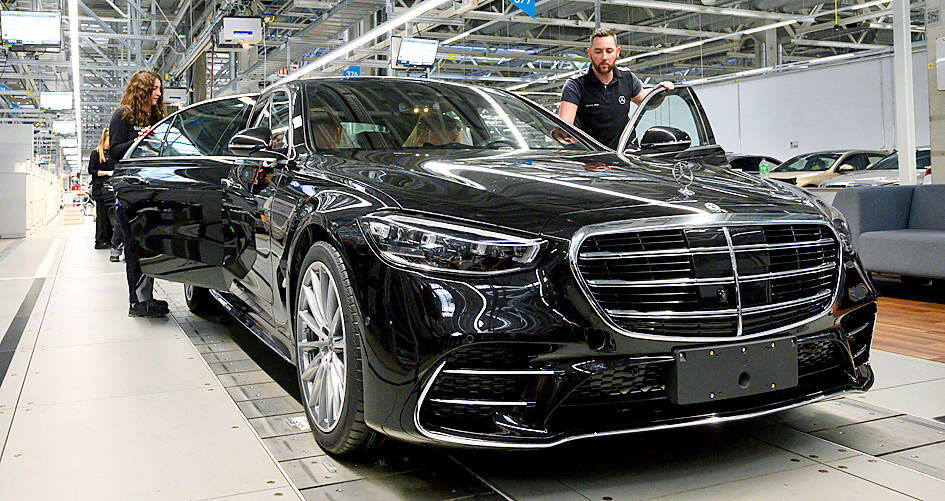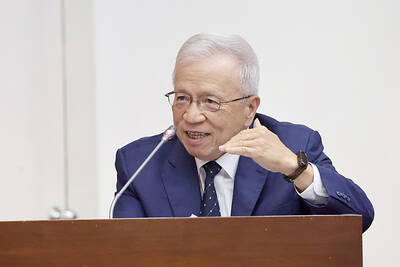Mercedes-Benz AG has tapped Google to assist with a reboot of software-based features that are expected to generate about 10 billion euros (US$10.6 billion) of additional revenue by the end of the decade.
The new operating system, to debut in about 2025, is scheduled to go into models spanning the entire Mercedes lineup and keep vehicles updated throughout their lifespan, the luxury automaker said on Wednesday.
Mercedes is working with select partners including Alphabet Inc, Nvidia Corp and Luminar Technologies Inc, but said it plans to keep a tight grip on technology to guard against revenue slipping away to tech competitors.

Photo: AFP
“When you build a software house, you don’t have to lay every single brick yourself or put up every single tile in the bathroom,” CEO Ola Kallenius said on Wednesday. “You’ve got to be in control as the architect, but leverage tech partnerships and make sure you work with the best.”
Automakers have tripped up on developing their own software functions that are outside of their decades-old hardware expertise. Last year, Volkswagen AG delayed new electric Audi and Porsche models because it could not acquire an accompanying operating system to work in time.
The jury remains out on who might profit most from the transformation into rolling computers. Software-enabled automotive revenue is expected to reach about US$700 billion by 2030, UBS Group AG said last year.
Mercedes expects to spend 25 percent of its research and development budget on software by 2025. Last year, the company generated more than 1 billion euros in revenue from software-based offerings such as navigation and live-traffic services.
The automaker forecast that this revenue should be in the high single-digit billion-euro range by the end of the decade.
It is cooperating with Nvidia on software and chips, and with Luminar on laser-based radar systems for driver-assistance features, the company said on Wednesday.
Mercedes is also hiring more software talent, and is close to reaching a target of adding about 3,000 new engineers, Kallenius said.
Nearer-term, Mercedes expects 1 billion euros in earnings before interest and taxes on software sales by 2025, chief financial officer Harald Wilhelm said on Wednesday.
That is split across existing infotainment and early offerings for autonomous driving. Mercedes disclosed that its agreement with Nvidia would see the chipmaker take half of net sales for autonomous software.
To keep margins strong through the electric vehicle and software transitions, Mercedes has shifted focus to top-end vehicles such as the G-Wagon sport utility vehicle. While this has paid dividends in the form of huge pricing gains, substantial discounts to flagship electric vehicles in China late last year suggest the company might have run up against limits to this strategy.
Aside from designing navigation technology with Google, which is to be done via a licensing deal, drivers are likely to have access to the YouTube app and hands-free driving in urban environments where regulation allows.
The company is also working on automated driving for speeds of up to 130kph. Mercedes last month said it plans to offer such features in the US for certain vehicles by the end of the year.

JITTERS: Nexperia has a 20 percent market share for chips powering simpler features such as window controls, and changing supply chains could take years European carmakers are looking into ways to scratch components made with parts from China, spooked by deepening geopolitical spats playing out through chipmaker Nexperia BV and Beijing’s export controls on rare earths. To protect operations from trade ructions, several automakers are pushing major suppliers to find permanent alternatives to Chinese semiconductors, people familiar with the matter said. The industry is considering broader changes to its supply chain to adapt to shifting geopolitics, Europe’s main suppliers lobby CLEPA head Matthias Zink said. “We had some indications already — questions like: ‘How can you supply me without this dependency on China?’” Zink, who also

At least US$50 million for the freedom of an Emirati sheikh: That is the king’s ransom paid two weeks ago to militants linked to al-Qaeda who are pushing to topple the Malian government and impose Islamic law. Alongside a crippling fuel blockade, the Group for the Support of Islam and Muslims (JNIM) has made kidnapping wealthy foreigners for a ransom a pillar of its strategy of “economic jihad.” Its goal: Oust the junta, which has struggled to contain Mali’s decade-long insurgency since taking power following back-to-back coups in 2020 and 2021, by scaring away investors and paralyzing the west African country’s economy.

BUST FEARS: While a KMT legislator asked if an AI bubble could affect Taiwan, the DGBAS minister said the sector appears on track to continue growing The local property market has cooled down moderately following a series of credit control measures designed to contain speculation, the central bank said yesterday, while remaining tight-lipped about potential rule relaxations. Lawmakers in a meeting of the legislature’s Finance Committee voiced concerns to central bank officials that the credit control measures have adversely affected the government’s tax income and small and medium-sized property developers, with limited positive effects. Housing prices have been climbing since 2016, even when the central bank imposed its first set of control measures in 2020, Chinese Nationalist Party (KMT) Legislator Lo Ting-wei (羅廷瑋) said. “Since the second half of

Taiwan Semiconductor Manufacturing Co (TSMC, 台積電) received about NT$147 billion (US$4.71 billion) in subsidies from the US, Japanese, German and Chinese governments over the past two years for its global expansion. Financial data compiled by the world’s largest contract chipmaker showed the company secured NT$4.77 billion in subsidies from the governments in the third quarter, bringing the total for the first three quarters of the year to about NT$71.9 billion. Along with the NT$75.16 billion in financial aid TSMC received last year, the chipmaker obtained NT$147 billion in subsidies in almost two years, the data showed. The subsidies received by its subsidiaries —